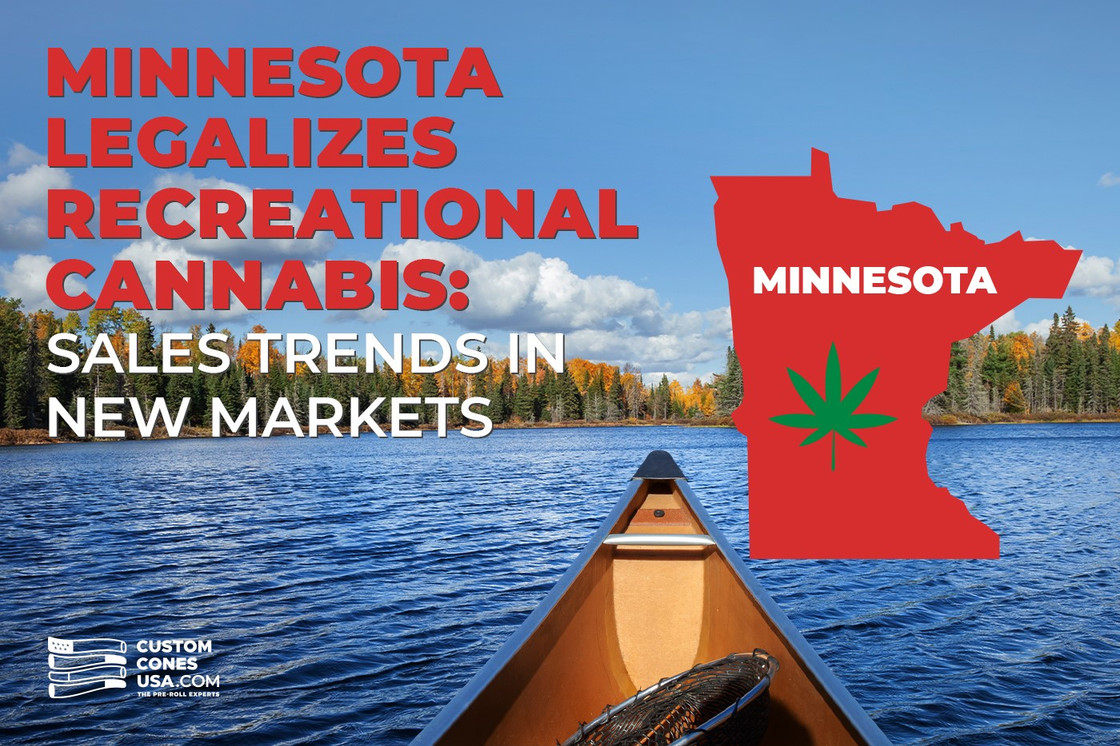Cannabis Legalized in Minnesota
Posted by Custom Cones USA on May 23rd 2023
In 2018, the Federal Government passed the Farm Bill which legalized the sale of hemp products. The bill mandated that the hemp plants could not test higher than 0.3% THC, but the bill had nothing to say about what the producers could do with that 0.3%. In other words, THC accidentally became legal in places like Minnesota.
To help bring some order to this situation, on July 1, 2022, Minnesota passed laws that legalized the sale of unregulated THC edibles and beverages. It was mandated that individual products (serving sizes) could not exceed 5 milligrams, a package of edibles could not exceed 50 milligrams, and that packaging had to be child proof. The biggest benefit of this law was that companies that produced and sold these products were not tied to the huge taxes that often come with owning a cannabis company.
Fast forward to today, and Minnesota has just passed a law to legalized recreational cannabis...again. This time it was on purpose, and the goal of the state was to create a market that aligned closer with already legalized markets. All the details are still being ironed out, and the companies that were already operating under the Farm Bill are worried that they will be forced to fold into the new system (licensing and regulations), but Minnesota is on its way to having a robust cannabis market soon.

Sales Data and Pre-Rolls in Emerging Markets
One of the benefits cannabis producers have in new markets is that they can use data from mature markets to help forecast trends in their own area. Of course, every market will be different and have unique characteristics, but there are also themes that stretch across regions and give us valuable information on how the cannabis industry will develop in new markets like Minnesota.
Let’s use Michigan as an example. After looking at pre-roll sales data from Headset, you can see that the price of pre-rolls skyrocketed when their recreational market opened at the end of 2019. As the market matured, the price declined, and sales rose until both eventually levelled out. You will also notice that, as the price of pre-rolls declined, more people started buying infused pre-rolls. This is great, but this is just one market. What about the others?

What’s really interesting about the themes we find in Michigan is that they are not limited to the Michigan market. If we look at the combined pre-roll sales data from Arizona, California, Colorado, Massachusetts, Michigan, Nevada, Oregon, and Washington in the next graph, we get something that looks very similar to the one we have for Michigan. Prices start high, but, as prices lower over time, sales increase and infused pre-rolls take up a larger share of the pre-roll market.

The decline in price is not limited to the pre-roll market either. The price of all cannabis products is directly tied to the price of cannabis flower, and, as that is slowly brought down through competition and a flooding of the market, it brings down the price of everything. We are now at the point where a consumer can get an infused pre-roll for the same price they could have gotten a regular pre-roll five years ago. With high THC numbers still being an important factor for consumers, it makes sense why infused pre-rolls become more popular as prices drop.
Another great thing about pre-rolls is that they are the cannabis product with the least amount of price compression. As you can see from the graph below, all product segments declined in price except for pre-rolls in the Canadian market, and pre-rolls in the US market showed the least amount of price compression when compared to other products. The biggest reason for this trend is the increase in popularity of infused pre-rolls, as they are single-handedly increasing the price of the average pre-roll.

The Future of Pre-Rolls in Minnesota
We have no reason to believe that a variation of this theme won’t play out in Minnesota, but there are things to consider. For example, pre-rolls may not need years to gain popularity in Minnesota. One of the reasons that pre-rolls were not popular in mature markets to begin with was that quality pre-rolls were not easy to make, and products that are not easy to make are expensive to buy. Thanks to advancements in pre-roll filling machines and automated infusion machines it is now easy for producers to create quality pre-rolls for a reasonable price.

We should also take into consideration the impact of the Farm Bill, which created a market for infused edibles before the recreational market opens. The connection between edibles and pre-rolls may not be immediately noticeable; however, when you look at the sales data from Headset, there is a clear connection. One of the reasons pre-rolls have such high sales is that they are the perfect add-on product, and pre-rolls are more likely to be added onto an order with edibles (over 20%) than any other product category. This could lead to higher pre-roll sales out of the gate, as the edible market is already established.
There are no guarantees on what will happen in the Minnesota’s recreational cannabis market, but, if it is anything like other markets that have opened, we can expect pre-rolls to be a major product segment sometime in the near future.
Fast forward to today, and Minnesota has just passed a law to legalized recreational cannabis...again. This time it was on purpose, and the goal of the state was to create a market that aligned closer with already legalized markets.

